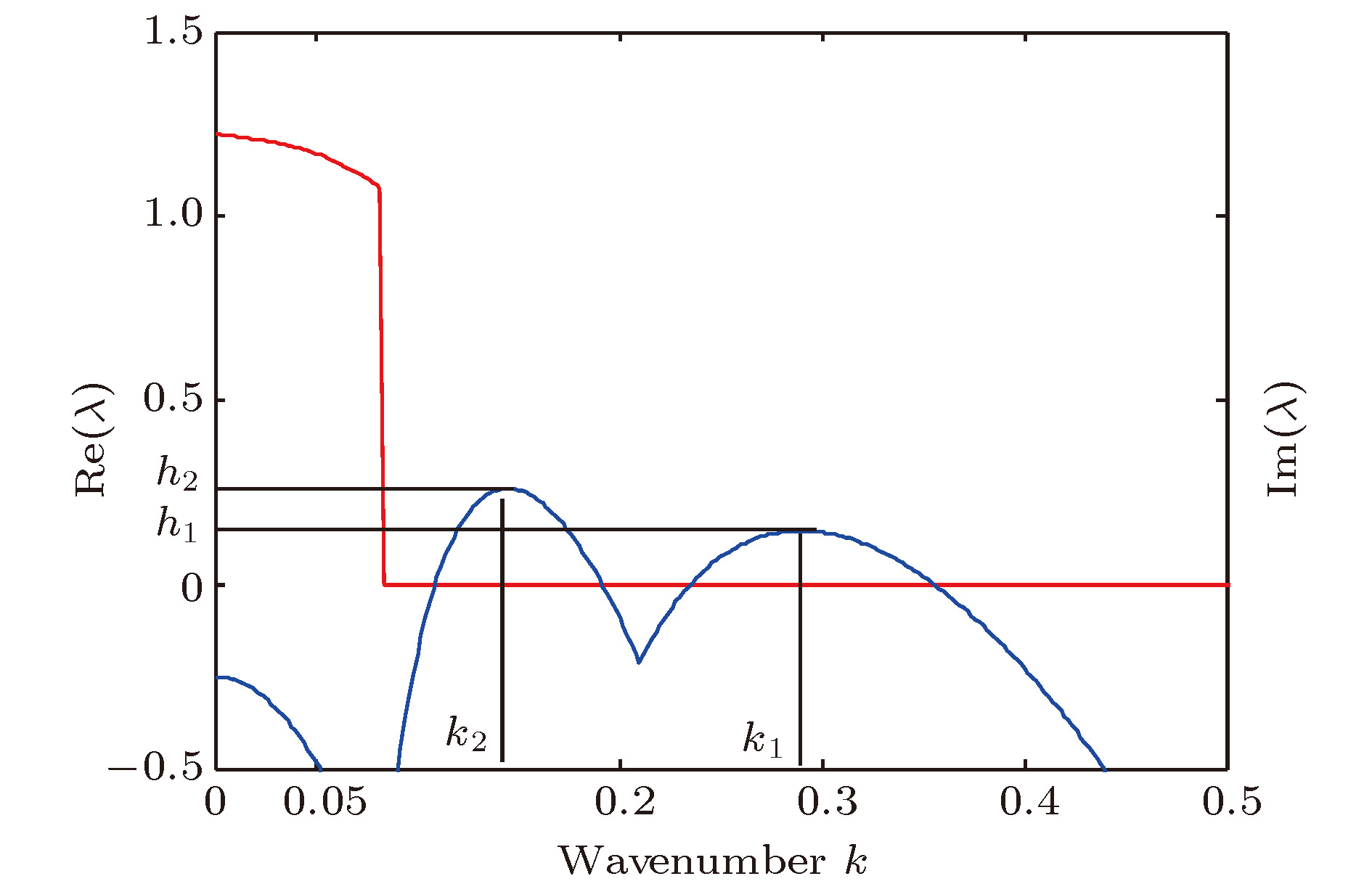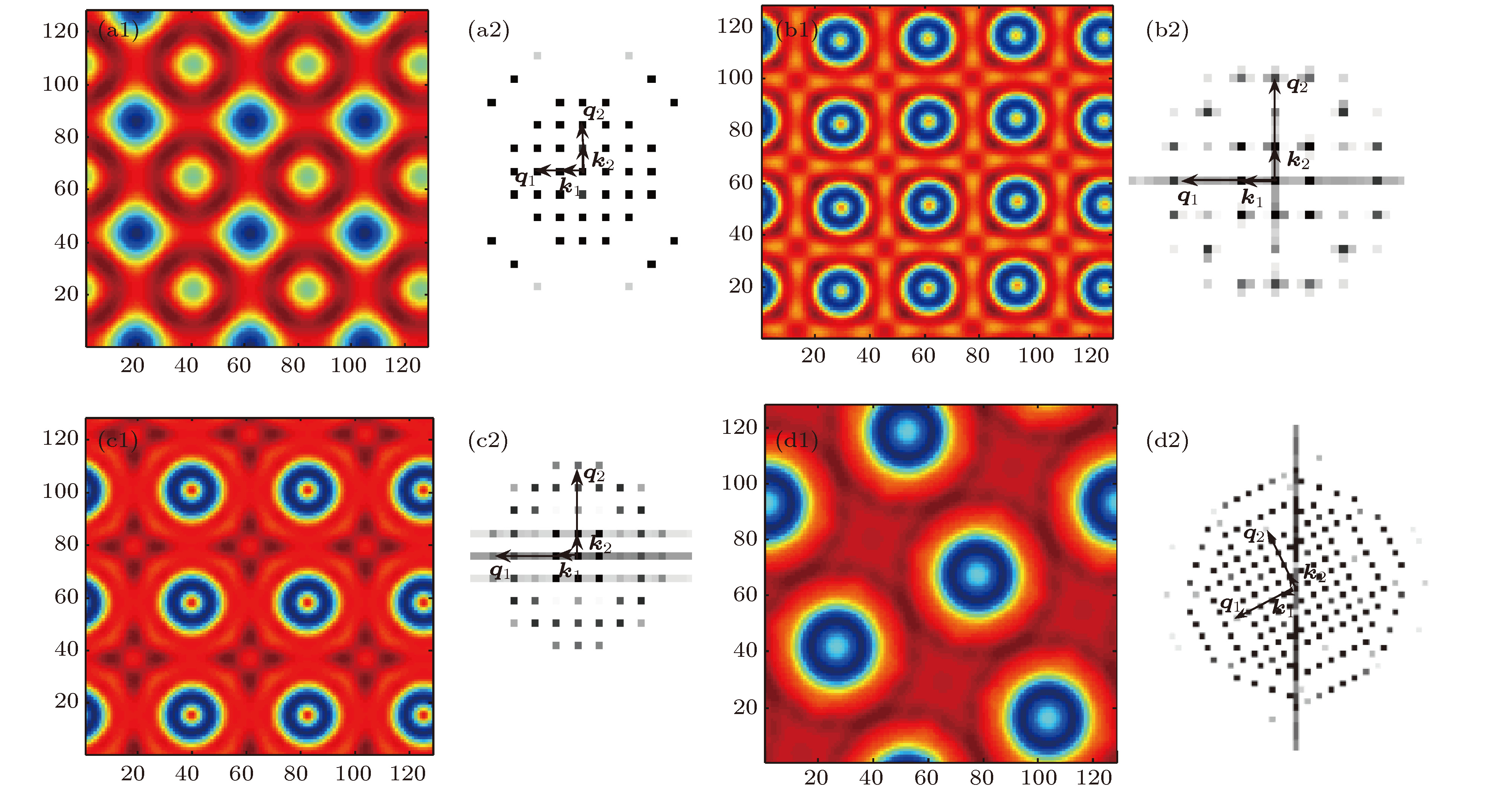-
采用双层线性耦合Lengyel-Epstein模型, 在二维空间对简单正四边和超点阵四边形进行了数值分析. 结果表明: 当两子系统波数比N>1时, 随耦合强度的增大, 基模的波矢空间共振形式发生改变, 系统由简单六边形自发演化为结构复杂的新型斑图, 除已报道的超六边形外, 还获得了简单正四边和多种超点阵四边形, 包括大小点、点线、白眼和环状超四边等斑图. 当耦合系数
$\alpha $ 和$\beta $ 在一定范围内同步增大时, 两子系统形成相同波长的I型简单正四边; 当$\alpha $ 和$\beta $ 不同步增大时, 由于两图灵模在短波子系统形成共振, 系统斑图经相变发生I型正四边→II型正四边→超点阵四边形的转变; 当系统失去耦合作用时, 短波子系统波长为$\lambda $ 的I型正四边斑图迅速失稳并形成波长为$\lambda $ /N的I型正四边, 随模拟时间的延长, 两子系统中不同波长的正四边均会经相变发生I型正四边→II型正四边→六边形的转变.-
关键词:
- Lengyel-Epstein模型 /
- 超点阵四边形 /
- 图灵失稳
In this paper, the simple and superlattice square patterns in two-dimensional space are investigated numerically by the two-layer coupled Lengyel-Epstein model. When the wave number ratio of Turing modes is greater than one, our results show that the spatial resonance form of the fundamental mode is changed with the increase of coupling strength, and simple hexagon pattern evolves spontaneously into a new pattern with a complicated structure. In addition to the reported superlattice hexagonal pattern, simple square pattern and superlattice square pattern are obtained, such as the complicated big-small spot, spot-line, ring and white-eye square pattern. The characteristics of simple and complicated superlattice square pattern are investigated by the intermediate process of evolution. When the coupling parameters$\alpha $ and$\beta $ increase synchronously within a certain range, the type I square patterns of the same wavelength are obtained in the two subsystems. When the coupling parameters$\alpha $ and$\beta $ increase asynchronously, the type I square pattern can evolve into the type II square pattern on the same spatial scale through phase transition. Then, the new subharmonic modes are generated, and the complicated superlattice square patterns are obtained due to the resonance between the two Turing modes in a short wavelength mode subsystem. The influence of coupling between two subsystems on the square pattern is investigated. When the type I square pattern of wavelength$\lambda $ emerges, the square pattern will quickly lose its stability in the short wavelength mode subsystem, since the coupling coefficient is equal to zero. Finally a new square pattern of wavelength$\lambda $ /N is formed. The type I square patterns of two subsystems successively evolve into the type II square patterns through the phase transition. The spots move relatively with the extension of simulation time, and a new mode is generated and forms three-wave resonance in two subsystems, and then the hexagonal pattern dominates the system. Our results also show that the type II square pattern spontaneously transforms into a hexagonal pattern.[1] Landry W, Werner B T 1994 Physica D 77 238
 Google Scholar
Google Scholar
[2] Zhou C X, Guo H Y, Ouyang Q 2002 Phys. Rev. E 65 036118
 Google Scholar
Google Scholar
[3] Pampaloni E, Residori S, Soria S, Arecchi F T 1997 Phys. Rev. Lett. 78 1042
 Google Scholar
Google Scholar
[4] Cysyk J, Tung L 2008 Biophys. J. 94 1533
 Google Scholar
Google Scholar
[5] 刘海英, 杨翠云, 唐国宁 2013 62 010505
 Google Scholar
Google Scholar
Liu H Y, Yang C Y, Tang G N 2013 Acta Phys. Sin. 62 010505
 Google Scholar
Google Scholar
[6] Le Gal P, Pocheau A, Croquette V 1985 Phys. Rev. Lett. 54 2501
 Google Scholar
Google Scholar
[7] Wagner C, Müller H W, Knorr K 2000 Phys. Rev. E 62 33
 Google Scholar
Google Scholar
[8] Yang L F, Dolnik M, Zhabotinsky A M, Epstein I R 2006 Chaos 16 037114
 Google Scholar
Google Scholar
[9] Dong L F, Fan W L, He Y F, Liu F C, Li S F, Gao R L, Wang L 2006 Phys. Rev. E 73 066206
 Google Scholar
Google Scholar
[10] Wei L Y, Dong L F, Feng J Y, Liu W B, Fan W L, Pan Y Y 2016 J. Phys. D: Appl. Phys. 49 185203
 Google Scholar
Google Scholar
[11] Pagea K M, Maini P K, Monk N A M 2005 Physica D 202 95
 Google Scholar
Google Scholar
[12] Yang L F, Zhabotinsky A M, Epstein I R 2004 Phys. Rev. Lett. 92 198303
 Google Scholar
Google Scholar
[13] Li J, Wang H L, Ouyang Q 2014 Chaos 24 023115
 Google Scholar
Google Scholar
[14] Judd S L, Silber M 2000 Physica D 136 45
 Google Scholar
Google Scholar
[15] Turing A M 1952 Philos. Trans. R. Soc. London, Ser. B 237 37
 Google Scholar
Google Scholar
[16] Qian Y, Gao H Y, Yao C G, Cui X H, Ma J 2018 Chin. Phys. B 27 108902
 Google Scholar
Google Scholar
[17] Mikhailova A S, Showalter K 2006 Phys. Rep. 425 79
 Google Scholar
Google Scholar
[18] 张荣培, 王震, 王语, 韩子健 2018 67 050503
 Google Scholar
Google Scholar
Zhang R P, Wang Z, Wang Y, Han Z J 2018 Acta Phys. Sin. 67 050503
 Google Scholar
Google Scholar
[19] Zhang L S, Liao X H, Mi Y Y, Qian Y, Hu G 2014 Chin. Phys. B 23 078906
 Google Scholar
Google Scholar
[20] Míguez D G, Dolnik M, Epstein I R, Muñuzuri A P 2011 Phys. Rev. E 84 046210
 Google Scholar
Google Scholar
[21] Gambino G, Lombardo M C, Sammartino M 2014 Acta Appl. Math. 132 283
 Google Scholar
Google Scholar
[22] Dong L F, He Y F, Liu W L, Gao R L, Wang H F, Zhao H T 2007 Appl. Phys. Lett. 90 031504
 Google Scholar
Google Scholar
[23] Barrio R A, Varea C, Aragon J L, Maini P K 1999 Bull. Math. Biol. 61 483
 Google Scholar
Google Scholar
[24] Dong L F, Fan W L, Pan Y Y 2010 Plasma Sci. Technol. 12 172
 Google Scholar
Google Scholar
-
图 4 (a)—(f)大小点超四边的形成过程, 模拟时间顺序为463.8, 827.9, 893.2, 927.8, 957.4, 975.0; (g) 空间傅里叶频谱; (h) 波形空间分布(
$\alpha = 0.085$ ,$\beta = 0.11$ , 其余参数见图2)Fig. 4. (a)−(f) Formation process of big-small spot square pattern, and the simulation time sequence is as follows: 463.8, 827.9, 893.2, 927.8, 957.4, and 975.0; (g) Fourier spectrum; (h) waveform diagram (
$\alpha = 0.085$ ,$\beta = 0.11$ , the other parameters is the same value of Fig. 2).图 5 不同波数比时系统形成的超四边形 (a)复杂大小点四边, Du1 = 11.885, Dv1 = 163.425, Du2 = 46.30, Dv2 = 671.25,
$\alpha = 0.075$ ,$\beta = 0.11$ ; (b) 点线四边, Du1 = 2.95, Dv1 = 41.15, Du2 = 25.75, Dv2 = 382.05,$\alpha = 0.085$ ,$\beta = 0.11$ ; (c)环状四边, Du1 = 2.95, Dv1 = 41.15, Du2 = 45.90, Dv2 = 677.05,$\alpha = 0.085$ ,$\beta = 0.11$ ; (d)白眼四边, Du1 = 2.95, Dv1 = 41.15, Du2 = 71.0, Dv2 = 1065.25,$\alpha = 0.075$ ,$\beta = 0.11$ Fig. 5. Square superlattice pattern at different wavenumber ratios: (a) Complex big-small spot square pattern, Du1 = 11.885, Dv1 = 163.425, Du2 = 46.30, Dv2 = 671.25,
$\alpha = 0.075$ ,$\beta = 0.11$ ; (b) spot-line square pattern, Du1 = 2.95, Dv1 = 41.15, Du2 = 25.75, Dv2 = 382.05,$\alpha = 0.085$ ,$\beta = 0.11$ ; (c) ring square pattern, Du1 = 2.95, Dv1 = 41.15, Du2 = 45.90, Dv2 = 677.05,$\alpha = 0.085$ ,$\beta = 0.11$ ; (d) white-eye square pattern, Du1 = 2.95, Dv1 = 41.15, Du2 = 71.0, Dv2 = 1065.25,$\alpha = 0.075$ ,$\beta = 0.11$ . -
[1] Landry W, Werner B T 1994 Physica D 77 238
 Google Scholar
Google Scholar
[2] Zhou C X, Guo H Y, Ouyang Q 2002 Phys. Rev. E 65 036118
 Google Scholar
Google Scholar
[3] Pampaloni E, Residori S, Soria S, Arecchi F T 1997 Phys. Rev. Lett. 78 1042
 Google Scholar
Google Scholar
[4] Cysyk J, Tung L 2008 Biophys. J. 94 1533
 Google Scholar
Google Scholar
[5] 刘海英, 杨翠云, 唐国宁 2013 62 010505
 Google Scholar
Google Scholar
Liu H Y, Yang C Y, Tang G N 2013 Acta Phys. Sin. 62 010505
 Google Scholar
Google Scholar
[6] Le Gal P, Pocheau A, Croquette V 1985 Phys. Rev. Lett. 54 2501
 Google Scholar
Google Scholar
[7] Wagner C, Müller H W, Knorr K 2000 Phys. Rev. E 62 33
 Google Scholar
Google Scholar
[8] Yang L F, Dolnik M, Zhabotinsky A M, Epstein I R 2006 Chaos 16 037114
 Google Scholar
Google Scholar
[9] Dong L F, Fan W L, He Y F, Liu F C, Li S F, Gao R L, Wang L 2006 Phys. Rev. E 73 066206
 Google Scholar
Google Scholar
[10] Wei L Y, Dong L F, Feng J Y, Liu W B, Fan W L, Pan Y Y 2016 J. Phys. D: Appl. Phys. 49 185203
 Google Scholar
Google Scholar
[11] Pagea K M, Maini P K, Monk N A M 2005 Physica D 202 95
 Google Scholar
Google Scholar
[12] Yang L F, Zhabotinsky A M, Epstein I R 2004 Phys. Rev. Lett. 92 198303
 Google Scholar
Google Scholar
[13] Li J, Wang H L, Ouyang Q 2014 Chaos 24 023115
 Google Scholar
Google Scholar
[14] Judd S L, Silber M 2000 Physica D 136 45
 Google Scholar
Google Scholar
[15] Turing A M 1952 Philos. Trans. R. Soc. London, Ser. B 237 37
 Google Scholar
Google Scholar
[16] Qian Y, Gao H Y, Yao C G, Cui X H, Ma J 2018 Chin. Phys. B 27 108902
 Google Scholar
Google Scholar
[17] Mikhailova A S, Showalter K 2006 Phys. Rep. 425 79
 Google Scholar
Google Scholar
[18] 张荣培, 王震, 王语, 韩子健 2018 67 050503
 Google Scholar
Google Scholar
Zhang R P, Wang Z, Wang Y, Han Z J 2018 Acta Phys. Sin. 67 050503
 Google Scholar
Google Scholar
[19] Zhang L S, Liao X H, Mi Y Y, Qian Y, Hu G 2014 Chin. Phys. B 23 078906
 Google Scholar
Google Scholar
[20] Míguez D G, Dolnik M, Epstein I R, Muñuzuri A P 2011 Phys. Rev. E 84 046210
 Google Scholar
Google Scholar
[21] Gambino G, Lombardo M C, Sammartino M 2014 Acta Appl. Math. 132 283
 Google Scholar
Google Scholar
[22] Dong L F, He Y F, Liu W L, Gao R L, Wang H F, Zhao H T 2007 Appl. Phys. Lett. 90 031504
 Google Scholar
Google Scholar
[23] Barrio R A, Varea C, Aragon J L, Maini P K 1999 Bull. Math. Biol. 61 483
 Google Scholar
Google Scholar
[24] Dong L F, Fan W L, Pan Y Y 2010 Plasma Sci. Technol. 12 172
 Google Scholar
Google Scholar
计量
- 文章访问数: 11153
- PDF下载量: 73
- 被引次数: 0




















 下载:
下载:
























